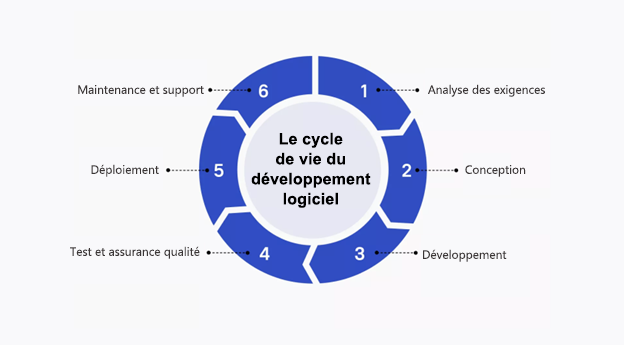Artificial Intelligence in the Software Development Lifecycle (SDLC)
GitHub Copilot’s capabilities go beyond individual coding tasks, influencing various stages of the Software Development Lifecycle (SDLC).
This unit explores how GitHub Copilot enhances different phases of the SDLC, from initial planning to deployment and maintenance.
Improving the Software Development Lifecycle (SDLC) with GitHub Copilot

Let’s examine how GitHub Copilot can have a positive impact at each stage of the Software Development Lifecycle (SDLC)
Requirements Analysis
Although GitHub Copilot does not directly gather requirements, it can help translate them into initial code structures:
- Rapid prototyping: Quickly generates code snippets from high-level descriptions, facilitating the development of proof-of-concept solutions.
- User story implementation: Transforms user stories into initial function or class definitions, serving as a starting point for development.
- API design: Suggests API structures based on described features, helping define system architecture.
Design and Development
This is where GitHub Copilot reveals its full potential, offering significant productivity gains:
- Boilerplate code generation: Automatically creates repetitive code structures, saving time on setup tasks.
- Design pattern implementation: Suggests patterns suited to the problem context, promoting best practices.
- Code optimization: Proposes more efficient alternatives, helping developers write performant code from the start.
- Language translation: Assists in translating concepts or code snippets between different programming languages.
Testing and Quality Assurance
GitHub Copilot can greatly simplify the testing process:
- Unit test creation: Generates test cases based on function signatures and behaviors, ensuring comprehensive coverage.
- Test data generation: Creates realistic datasets, reducing manual creation time.
- Edge case identification: Suggests test scenarios covering extreme cases, strengthening test robustness.
- Assertion suggestions: Proposes appropriate assertions based on expected code behavior.
Deployment
While GitHub Copilot is not directly involved in deployment processes, it can assist with related tasks:
- Configuration file generation: Helps create configuration files for different deployment environments.
- Deployment script assistance: Suggests commands or scripts for common deployment tasks.
- Documentation updates: Assists in updating deployment documentation to reflect recent changes.
Maintenance and Support
GitHub Copilot is also useful for ongoing maintenance tasks:
- Bug fix suggestions: Offers potential solutions to reported issues based on error messages and surrounding code.
- Code refactoring: Suggests improvements to existing code, helping maintain a modern and efficient codebase.
- Documentation updates: Helps keep code comments and documentation up to date with changes.
- Legacy code understanding: Assists developers in understanding and working with old or unfamiliar code by providing explanations and modern equivalents.
By integrating GitHub Copilot throughout the SDLC, development teams can benefit from greater efficiency, improved consistency, and higher code quality at every stage of the process. This AI-assisted approach allows developers to focus more on creative problem-solving and less on repetitive tasks, potentially leading to faster development cycles and better software.
In the next unit, we will explore the limitations of GitHub Copilot and discuss ways to measure its impact on development productivity.
